Russia's Arctic towns prepare for more polar bear 'invasions' as sea ice melts

Airport maintenance worker Ruslan Prikazchikov was coming to the end of a night shift last week when he glanced out the window and saw a polar bear walking down the taxiway, stopping every few feet to look around.
He wasn't overly concerned. As a lifelong resident of Amderma, a hardscrabble former mining and military town perched on the edge of the Arctic Ocean 1,200 miles northeast of Moscow, Mr Prikazchikov has seen more than a hundred polar bears first-hand. He took a quick video on his phone, yelled out the window so the bear would keep moving and put the kettle on for tea.
“It's par for the course,” he said. “They were always here. They are the masters here, so we don't conflict with them, and they don't show aggression toward us.”
The “tsar of the Arctic” has indeed always been part of life in Amderma. It features in the folktales of indigenous Nenets reindeer herders, and old photographs show Soviet soldiers feeding condensed milk to polar bears well within reach of their razor-sharp two-inch claws. Some residents even admitted to having poached the animals in the hungry 1990s, when a hide was said to fetch $10,000.
But as global warming melts the polar sea ice, these marine hunters are increasingly being forced onto land. The risk is rising of conflict with the humans, who are also arriving in greater numbers as Russia develops oil and gas deposits and expands its military capabilities in the Arctic.
In response, coastal towns have started to organise “polar bear patrols” to scare off intruders with snowmobiles and flares.
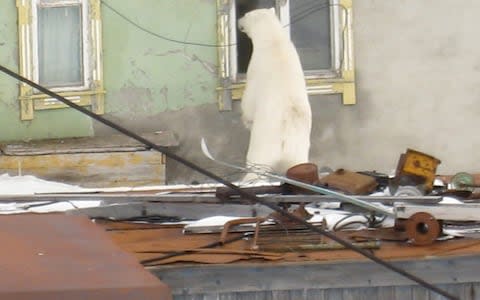
Almost every resident of Amderma has seen a polar bear, even the youngest, and many are surprisingly blasé about the predators' presence. Anastasia Popovich, now 15, was walking home with friends in May 2016 when they ran into a bear cub they initially mistook for a huge white dog.
“The white thing turned, and we understood that it wasn't a dog,” she remembered. “We saw the cub turn toward us and we froze in horror.”
The girls tried to hide in a nearby abandoned building but couldn't open the door, so they ran to the guard booth at a vehicle depot.
“Afterward all their how-I-spent-my-holiday essays were about bears, some were even bragging,” said her mother Yelena Alyoshina, a teacher at the local school.
Her father, a member of the local polar bear patrol, had had an even closer call when he came face to face with a bear coming out of his fishing hut once the year before that. Luckily, the creature immediately ran from his shouts.
“It was terrifying just because it was such a surprise. I just yelled,” Yury Popovich said. “If he didn't like me he could have hit me with a paw or grabbed me.”

Eight polar bears have come into Amderma already this year, compared to five all last year, according to Eduard Davletshin, the head of the patrol. He grew up in a house on the seashore frequented by bears and would sometimes had to stay home from school because one was lurking outside. But he said there have been more bears in Amderma in the past decade.
“They used to go on the ice to hunt seals,” he said. “Now there's no ice, they have no choice. They go along the shore, and the town is in the way.”
Although it is the world's largest land predator, the polar bear actually prefers to spend its time on sea ice and is classified as the “sea bear,” or “Ursus maritimus”. Called the “white bear” in Russian, it blends in almost seamlessly as it sneaks up to breathing holes to snatch harp or spotted seals, as shown in David Attenborough's Our Planet series last month.
Bears often swim more than 100 miles to reach ice packs and can spend almost all of their lives at sea. That is changing, however, with global warming.
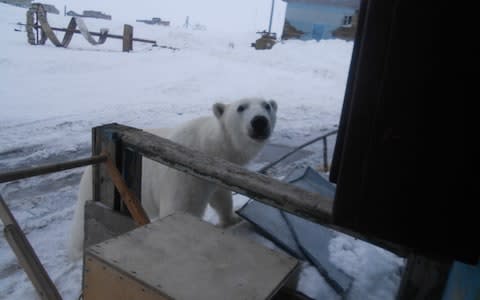
In February, the restricted-access military town of Belushya Guba across the Kara Strait from Amderma declared a state of emergency following an “invasion” of 52 polar bears. CCTV cameras caught one polar bear walking the hallway to a young family's flat.
“The emotions are indescribable, adrenaline, terror and the question 'what to do,'” postal worker Nadezhda Kireyeva told The Telegraph at the time.
Experts blamed the invasion on the lack of sea ice and an open rubbish dump where groups of bears were seen foraging.
The predators departed when sea ice finally formed off the coast in late February. But that can hardly be counted on for the future.

This year, Arctic sea ice hit a new record low for April, and a study predicted that the Arctic Ocean would become ice-free in the summer within the next 20 years.
In Amderma, the “fast ice” that is firmly attached to the coast has been forming later and not growing as thick, according to meteorologist Nelli Shuvalova, who has been measuring the ice here twice a day since 1981.
This year, the maximum extent of the fast ice was 10 kilometres—some years it has stretched to the horizon 26 kilometres away—and its maximum thickness was 60 centimetres.
“That's really small,” Ms Shuvalova said. “The ice is thin for bears.”
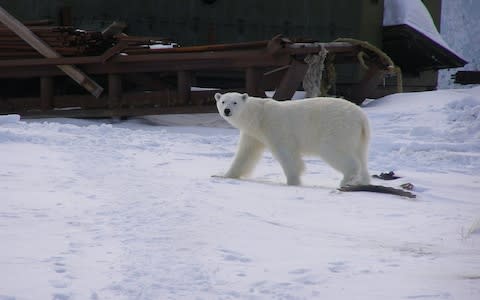
“We have a catastrophic situation with the fast ice,” polar bear expert Ilya Mordvintsev said while visiting Amderma last week. “When the ice comes south in the winter, so do the bears. When it recedes the majority don't make it back onto the ice.”
These stragglers tend to head north along the coast in search of ice—which means towns like Amderma are now essentially located on a polar bear highway.
Amderma was home to as many as 20,000 people before a fighter jet regiment moved away in 1993. Today it has just 300 residents, though its town hall hopes to boost its fortunes by attracting back Russian troops, as well as scientists and tourists.

Either way, those townspeople still here are mostly determined to stay, and 25 children attend the town school—which is located next to a windswept beach frequented by bears. Whenever one comes into the town, the school calls parents to take their children home early.
Other Arctic settlements are growing quickly. Belushya Guba, with a population of 2,000, is developing a new military facilities, airstrip and port, and there are plans to mine lead and zinc nearby.
In March, state gas giant Gazprom began operations at a new Arctic gasfield in Yamal, near the Sabetta terminal that has shipped liquified gas to buyers in the UK and elsewhere. Moscow has also revamped several Arctic military bases in recent years.
On Saturday, top officials launched the world's largest nuclear-powered icebreaker, one of nine promised by the country's president in April to keep hydrocarbons flowing to Asia along its northern sea route..
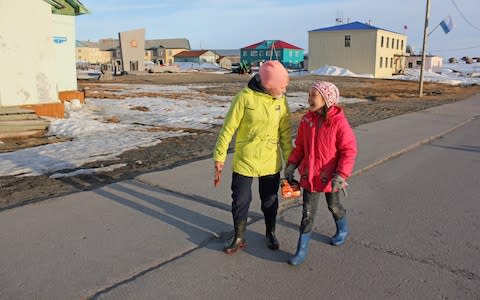
All that increases the risk of human-bear run-ins, which can turn violent if the animal is ill or hungry—or is provoked by boorish behaviour.
An oil and gas worker was killed by a polar bear on Franz Josef Land in 2016, and a meteorologist was killed there in 2011.
While polar bears can weigh upward of 1,300 pounds and run 25 miles per hour or faster, they aren't typically aggressive toward humans and can usually be scared off by loud noises and moving vehicles.
“To avoid instances of harm to people and shooting of polar bears as problematic animals, it's better to take action creating these bear patrols that could avoid such conflict situations,” Mr Mordvintsev said.
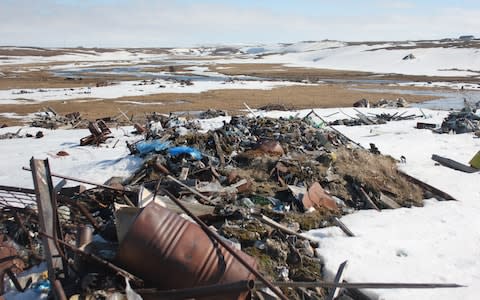
Amderma hunters started a polar bear patrol in 2017 with flares, rubber bullets and flashbangs from the regional government and a quad cycle from WWF. Due to fuel problems, they more often ride their own snowmobiles.
Similar groups have been started in the nearby towns of Ust-Kara and Varnek. Other measures include a CCTV system installed last year at a weather station on a nearby island, which clued in scientists to stay inside behind barred windows while a polar bear nosed around outside in February.
During their visit last week, WWF and regional officials promised the Amderma patrol radios, fuel and satellite phones to upload photographs of bears. They also played top 40 dance hits to test the loudspeaker warning system, which residents have complained is too quiet and unreliable.

At a meeting in the hall of the Soviet-built “palace of culture,” Mr Mordvintsev and WWF employees advised locals not to run from any polar bear they might see but rather back away slowly, so as not to trigger its predatory instinct.
If they don't have something to bang on, they should make a “sh” sound to mimic bears' own warning vocalisations.
In reality, residents said they're more afraid of Arctic foxes, which can be aggressive and infected with rabies. They often like to photograph polar bears that come—and some have even taken selfies with the creatures.
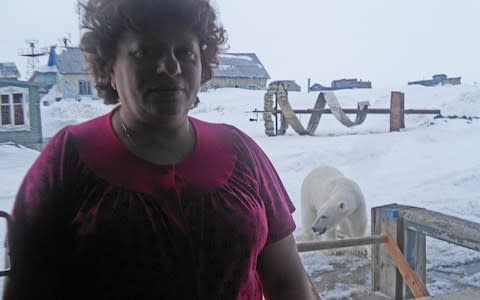
The meeting finished with a short debate about whether scientists should try to save the polar bear at all.
“The polar bear is the top of the food chain and a symbol of the Arctic,” Mr Mordvintsev said. “If there was no polar bear, what would we do here? If there was no polar bear here, would you be at peace?”
The audience began murmuring before one woman came up with an answer: “It would be boring!”

 Yahoo News
Yahoo News 
